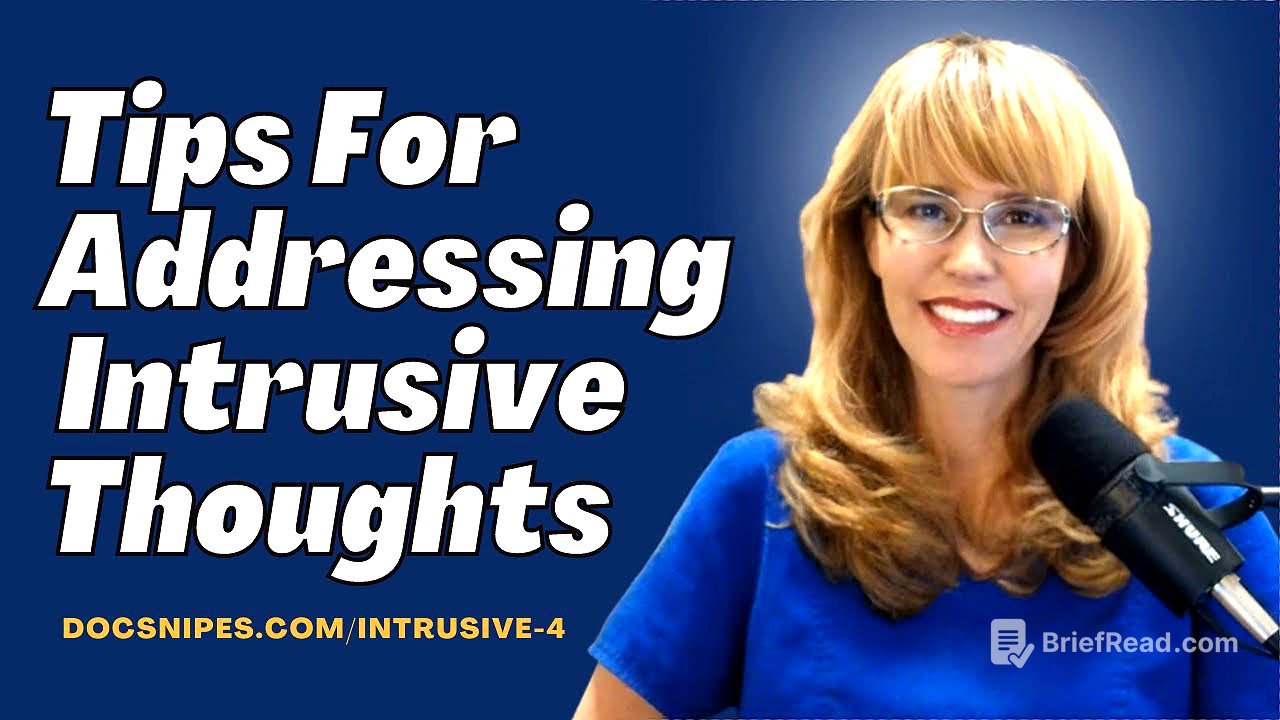TLDR;
This video by Doc Snipes provides a concise guide on managing intrusive thoughts. It defines intrusive thoughts, explores their various types, and offers practical techniques to handle them. The video emphasizes distraction, cognitive unhooking, guided imagery, and recognizing "proof negative" to counter these unwanted thoughts. It also highlights the importance of seeking professional help if intrusive thoughts persist or significantly impair one's quality of life, as they may be indicative of underlying conditions like anxiety, depression, PTSD, or OCD.
- Intrusive thoughts are unwanted, involuntary thoughts that can be triggered by stress, anxiety, or hormonal changes.
- Techniques like distraction, unhooking, guided imagery, and recognizing proof negative can help manage intrusive thoughts.
- Persistent or impairing intrusive thoughts may indicate underlying mental health conditions requiring professional help.
Introduction: Understanding Intrusive Thoughts [0:01]
The video introduces the concept of intrusive thoughts, defining them as unwanted and involuntary thoughts that can manifest in various forms. According to the Anxiety and Depression Association of America, these thoughts often have no basis in reality and are perceived as unacceptable by the individual experiencing them. Intrusive thoughts can be triggered by factors such as stress, anxiety, insomnia, or hormonal fluctuations, and they can be associated with conditions like anxiety, depression, postpartum depression, PTSD, or obsessive-compulsive disorder. The presenter emphasizes that if these thoughts are frequent or significantly impact one's quality of life, seeking professional help from a doctor or therapist is crucial to develop effective coping strategies.
Types of Intrusive Thoughts [1:48]
The video explores different types of intrusive thoughts, including negative self-perceptions ("I'm an idiot"), violent thoughts (harming a child, fear of fire or burglary), and compulsive thoughts or cravings (needing a cigarette or a piece of cake). It addresses the common occurrence of intrusive thoughts in women during the postpartum period, clarifying that experiencing such thoughts and being appalled by them does not indicate postpartum psychosis. The key differentiator is that in postpartum psychosis, the individual is not disturbed by these thoughts. The presenter stresses the importance of developing a support system and consulting with healthcare professionals if these thoughts are bothersome during the postpartum period.
Technique 1: Distract, Don't React [3:42]
The video introduces the first technique for handling intrusive thoughts, which involves treating them like persistent salespeople trying to convince you of something unrealistic. The presenter advises against arguing with or buying into these thoughts, as giving them attention only prolongs their presence. Instead, the recommended approach is to ignore the thoughts and distract oneself by engaging in alternative activities such as doing sit-ups, going for a walk, or calling a friend. The presenter emphasizes that overthinking or analyzing the thoughts can strengthen the neural pathways associated with them, making it crucial to break the cycle by distracting rather than reacting.
Technique 2: Unhooking from Thoughts [6:41]
The video introduces the "unhooking" technique, which involves recognizing that thoughts are merely words and images that do not necessarily lead to actions. The presenter suggests viewing intrusive thoughts as a bad movie that one can simply change the channel from. To unhook from these thoughts, one can reframe them by saying, "I'm having the thought that..." (e.g., "I'm having the thought that I'm in danger") to create distance. Another strategy is to mentally pack the thought into a "thought box" and place it on a shelf, acknowledging its existence without allowing it to dominate one's current state of mind.
Technique 3: Guided Imagery and Distraction [8:20]
The video suggests developing a guided imagery script or focusing on something else entirely to divert attention from intrusive thoughts. Since it's impossible to concentrate on two things simultaneously, actively shifting focus to a pleasant or engaging topic, such as an upcoming vacation or future plans, can be effective. Guided imagery involves creating a mental image of safety and empowerment, which can be particularly useful when dealing with specific intrusive thoughts.
Technique 4: Recognizing Proof Negative [9:34]
The video introduces the concept of "proof negative," which involves recognizing and focusing on instances that contradict intrusive thoughts. The presenter shares a personal experience with postpartum depression and intrusive thoughts, explaining how she coped by acknowledging the many days she had successfully cared for her child without acting on those thoughts. This realization served as proof that she could have these thoughts without being controlled by them. Similarly, when dealing with negative self-perceptions, it's important to notice and focus on instances where one performs well or achieves positive outcomes, counteracting the intrusive thoughts.
When to Seek Professional Help [12:00]
The video concludes by emphasizing that if intrusive thoughts persist or cannot be managed effectively, it may indicate an underlying condition such as anxiety, depression, PTSD, or obsessive-compulsive disorder. In such cases, seeking professional help from a doctor or therapist is crucial to explore appropriate treatments and strategies for managing these thoughts and addressing any underlying mental health concerns.









